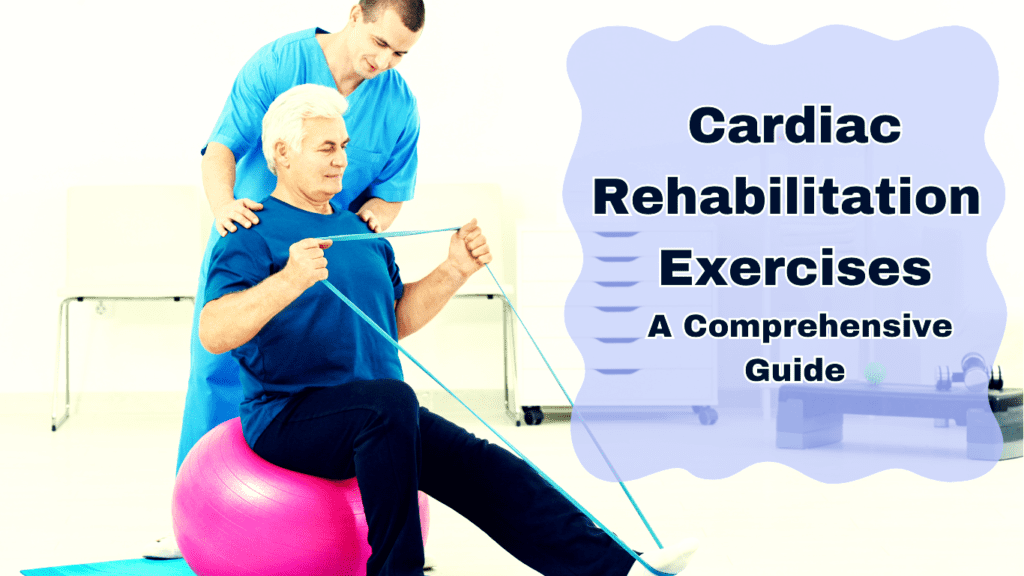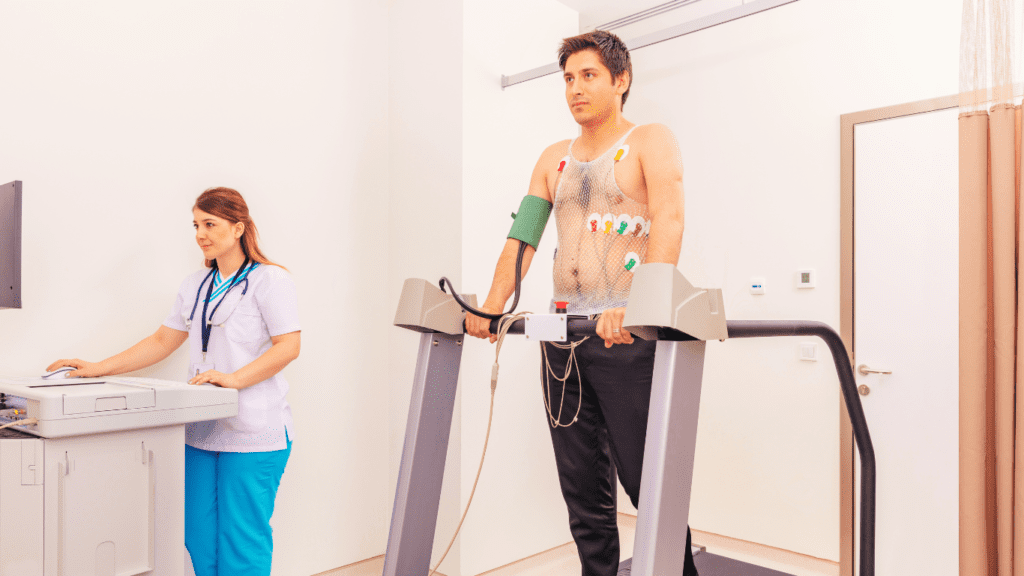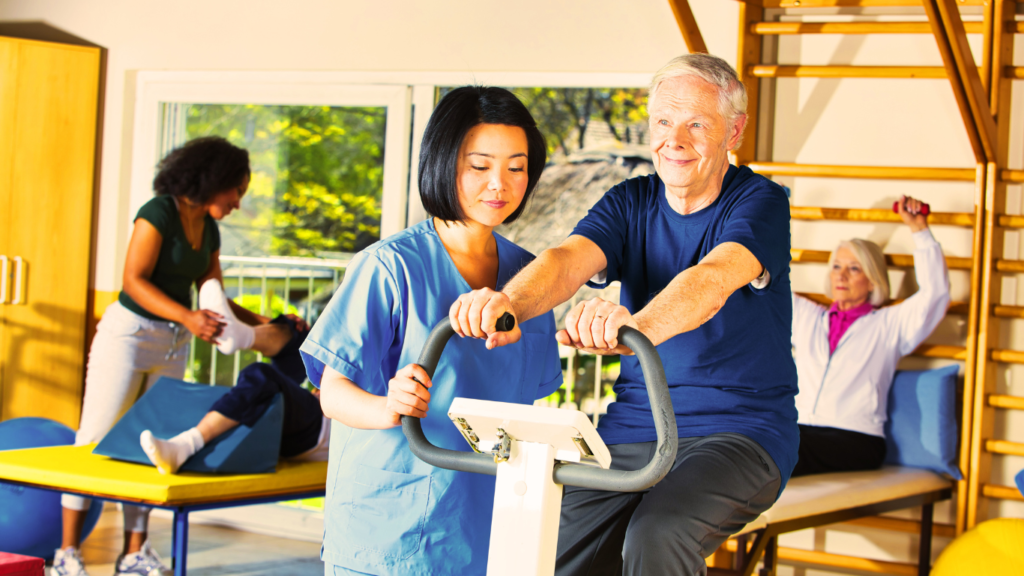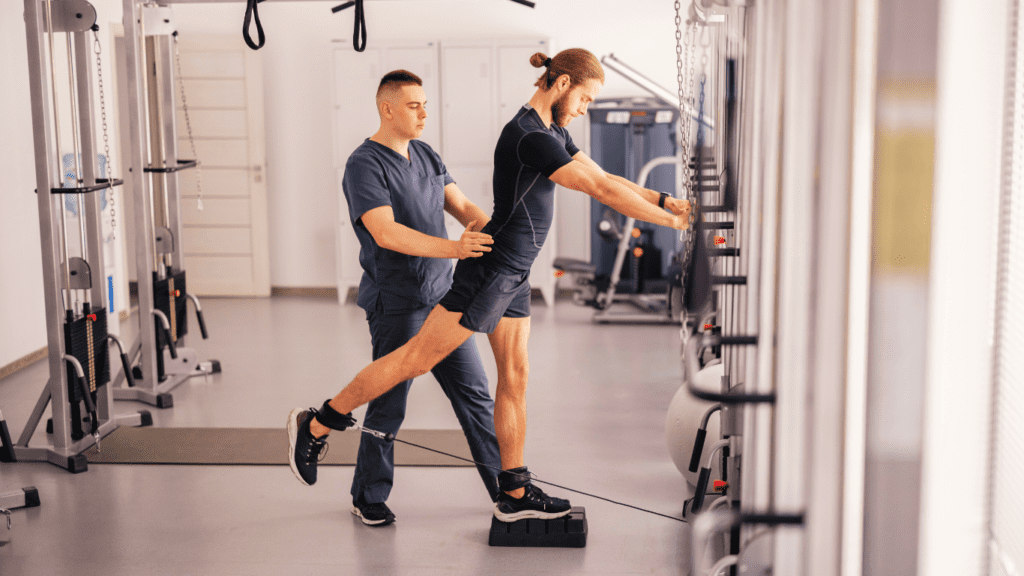Introduction to Cardiac Rehabilitation Exercises: A Comprehensive Overview
In this article, we will explore how cardiac rehabilitation exercises can transform heart health, improve recovery, and reduce the risk of future cardiac events, offering a comprehensive guide for a stronger, healthier life.
Did you know that cardiac rehabilitation can reduce the risk of death from heart disease by up to 30%? This remarkable statistic highlights the critical role that cardiac rehabilitation exercises play in recovering from heart-related issues. In this comprehensive guide, we will delve into the various aspects of cardiac rehabilitation exercises, ensuring that you or your loved ones can embark on a safe and effective recovery journey.
This article will cover several essential topics to provide a thorough understanding of cardiac rehabilitation. First, we’ll delve into understanding cardiac rehabilitation, exploring what it entails and why it is crucial for heart health. Following that, we’ll discuss the benefits of cardiac rehabilitation exercises, highlighting how they can improve your overall well-being and cardiovascular health.
Next, we will look at the types of cardiac rehabilitation exercises, explaining the different forms of exercises that can be incorporated into a rehabilitation program. This will be followed by a section on how to create a personalized exercise plan, ensuring that your routine is tailored to your specific needs and capabilities.

Safety is paramount, so we will cover safety considerations to ensure that you exercise safely and effectively. Additionally, we will explore lifestyle modifications that can support your heart health and enhance the benefits of your exercise routine. Finally, we will provide information on resources and support available to you, from professional guidance to community support systems.
Understanding cardiac rehabilitation is the foundation of this guide. Cardiac rehabilitation is a medically supervised program designed to improve cardiovascular health for people who have experienced heart attacks, heart surgery, or other heart-related conditions. It involves a combination of physical activity, education about healthy living, and counseling to reduce stress and improve mental health. The goal is not only to help patients recover but also to prevent future heart problems by promoting heart-healthy habits.
The benefits of cardiac rehabilitation exercises are numerous. Regular participation in these exercises can lead to improved heart function, increased physical fitness, reduced symptoms of heart disease, and an enhanced quality of life. Moreover, these exercises can help lower blood pressure, improve cholesterol levels, and manage diabetes more effectively. Engaging in a structured exercise program under professional supervision ensures that patients receive the maximum benefit while minimizing the risk of complications.
Subscribe And Get Our Free E-Book:Unlocking The Power Of Nutrition-Supplements, Substitutes, and Superfoods!
When it comes to the types of cardiac rehabilitation exercises, there is a variety to choose from. Aerobic exercises such as walking, cycling, and swimming are commonly recommended as they help improve the efficiency of the cardiovascular system. Strength training exercises, which involve the use of weights or resistance bands, are also beneficial as they help build muscle strength and endurance. Flexibility exercises, including stretching and yoga, are crucial for maintaining joint health and preventing injuries. Each type of exercise plays a unique role in the overall rehabilitation process and contributes to a well-rounded fitness program.
Creating a personalized exercise plan is essential for achieving the best outcomes from cardiac rehabilitation. A personalized plan takes into account an individual’s medical history, current fitness level, and personal goals. It typically starts with a baseline assessment conducted by a healthcare professional, followed by a tailored exercise regimen that progressively increases in intensity. This approach ensures that the patient can safely and gradually improve their fitness without overexerting themselves. Regular monitoring and adjustments to the plan help maintain progress and address any emerging challenges.
Safety considerations are critical in any exercise program, especially for those recovering from heart-related issues. It is important to start slowly and gradually increase the intensity of the exercises. Patients should be aware of their limits and stop exercising immediately if they experience symptoms such as chest pain, shortness of breath, dizziness, or excessive fatigue. Staying hydrated, wearing appropriate clothing, and avoiding extreme temperatures can also help prevent complications. Consulting with a healthcare provider before starting any new exercise routine is essential to ensure it is safe and appropriate for the individual’s condition.
In addition to exercise, lifestyle modifications play a significant role in cardiac rehabilitation. Adopting a heart-healthy diet, quitting smoking, managing stress, and maintaining a healthy weight are all crucial components of a comprehensive rehabilitation plan. These lifestyle changes complement the benefits of cardiac rehabilitation exercises and contribute to long-term heart health. Patients are often provided with educational resources and counseling to support these changes, making it easier to adopt and maintain healthier habits.
Finally, accessing resources and support can make a significant difference in the success of cardiac rehabilitation. Many hospitals and clinics offer cardiac rehabilitation programs with trained professionals who provide guidance and support throughout the recovery process. Community resources, such as support groups and online forums, can also offer encouragement and advice from others who have gone through similar experiences. Leveraging these resources ensures that patients have the support they need to stay motivated and committed to their rehabilitation journey.
Cardiac rehabilitation exercises are a vital component of recovery for individuals with heart-related issues. By understanding the different aspects of cardiac rehabilitation, from the types of exercises to safety considerations and lifestyle modifications, patients can effectively improve their heart health and overall well-being. With the right support and resources, embarking on this journey can lead to a healthier, more fulfilling life.
Understanding Cardiac Rehabilitation
Understanding cardiac rehabilitation is essential for anyone recovering from heart-related issues or aiming to improve their cardiovascular health. Cardiac rehabilitation is a comprehensive, medically supervised program designed to enhance the heart health and overall well-being of individuals who have experienced heart attacks, heart surgeries, or other cardiac events. This program involves a multidisciplinary approach that combines medical evaluation, physical activity, lifestyle education, and counseling to foster recovery and prevent future heart problems.
To fully grasp the importance of cardiac rehabilitation exercises, it’s crucial to understand their primary goals. The foremost objective is to improve cardiovascular health, which includes strengthening the heart muscle, enhancing blood flow, and increasing overall stamina. Another significant goal is to reduce the risk of future heart problems by encouraging heart-healthy habits and monitoring any potential risk factors. These objectives are not only about physical recovery but also about mental and emotional well-being, as managing stress and improving mental health are integral parts of the process.

The components of a cardiac rehabilitation program are diverse and tailored to meet individual needs. The first component is a medical evaluation, which involves a thorough assessment by healthcare professionals to determine the patient’s current health status and identify any specific needs or limitations. This evaluation forms the foundation for developing a personalized rehabilitation plan.
Next is the physical activity component, which is the core of cardiac rehabilitation exercises. This involves a structured exercise program tailored to the individual’s fitness level and health status. Activities typically include aerobic exercises like walking, cycling, and swimming, which help improve cardiovascular endurance. Strength training exercises are also incorporated to build muscle strength and support overall physical health. Flexibility exercises, such as stretching and yoga, are included to enhance joint mobility and reduce the risk of injury. Each exercise type is chosen to contribute uniquely to the overall goal of improving heart health.
The lifestyle education component is equally important in cardiac rehabilitation. Patients are educated about heart-healthy habits, such as proper nutrition, smoking cessation, and weight management. This education is aimed at empowering patients to make informed choices that will support their long-term heart health. Topics covered often include understanding heart disease, the importance of medication adherence, and strategies for managing stress. By gaining knowledge and skills, patients can take an active role in their recovery and long-term health maintenance.
Counseling and emotional support are also critical elements of cardiac rehabilitation. Heart disease and recovery can be stressful and emotionally challenging, and addressing these aspects is vital for overall recovery. Counseling sessions provide patients with coping strategies, help manage anxiety or depression, and offer support for making lasting lifestyle changes. Emotional well-being is closely linked to physical health, and addressing mental health issues can significantly enhance the effectiveness of the rehabilitation program.
The integration of these components ensures that cardiac rehabilitation exercises are not just about physical activity but encompass a holistic approach to recovery and long-term health. The structured nature of the program, combined with professional supervision, ensures that patients can progress safely and effectively. Regular monitoring and adjustments to the exercise regimen are made based on the patient’s progress and any emerging needs, ensuring that the program remains relevant and effective.
By participating in a cardiac rehabilitation program, patients gain a comprehensive support system that guides them through recovery. This support system includes healthcare providers, exercise specialists, dietitians, and mental health professionals, all working together to provide a coordinated and personalized approach to care. This multidisciplinary team approach ensures that all aspects of the patient’s health are addressed, promoting a more complete and sustainable recovery.
In addition to the structured program, patients are encouraged to integrate the principles of cardiac rehabilitation into their daily lives. This means continuing with regular physical activity, adhering to a heart-healthy diet, and maintaining lifestyle changes even after the formal program has ended. Long-term adherence to these principles is crucial for sustaining the benefits gained during the rehabilitation period and for continuing to improve heart health over time.
The importance of cardiac rehabilitation exercises cannot be overstated. They are a vital tool in the recovery process for anyone who has experienced a cardiac event. The structured, supervised nature of these programs ensures that patients can safely and effectively regain their strength, improve their cardiovascular health, and reduce the risk of future heart problems. By understanding the goals and components of cardiac rehabilitation, individuals can appreciate the comprehensive approach taken to support their recovery and long-term health.
In summary, cardiac rehabilitation is a multifaceted program designed to improve heart health and overall well-being. Through a combination of medical evaluation, physical activity, lifestyle education, and emotional support, patients are guided through a recovery process that addresses both physical and mental health. The holistic approach of cardiac rehabilitation exercises not only aids in recovery but also equips patients with the knowledge and skills needed to maintain a heart-healthy lifestyle in the long run.
Benefits of Cardiac Rehabilitation Exercises
Engaging in cardiac rehabilitation exercises offers a multitude of benefits that extend beyond mere physical recovery. These exercises are a cornerstone of heart health improvement, contributing significantly to overall well-being. By participating in a structured program, individuals can achieve a range of physical, emotional, and long-term health benefits that collectively enhance their quality of life and reduce the risk of future cardiac events.

The physical benefits of cardiac rehabilitation exercises are substantial. One of the primary advantages is improved cardiovascular fitness. Regular aerobic exercises, such as walking, cycling, and swimming, help to strengthen the heart muscle, making it more efficient at pumping blood throughout the body. This increased efficiency translates to better oxygen delivery to tissues and organs, which is essential for overall health and stamina. Enhanced cardiovascular fitness also means that everyday activities become easier and less tiring, allowing individuals to lead more active and fulfilling lives.
Another significant physical benefit is increased muscle strength. Strength training exercises, which might include the use of weights or resistance bands, are incorporated into cardiac rehabilitation programs to help build and maintain muscle mass. Stronger muscles support better posture, balance, and mobility, reducing the risk of falls and other injuries. Improved muscle strength also contributes to greater endurance, enabling individuals to engage in physical activities for longer periods without fatigue.
Flexibility is another important aspect of physical health that is improved through cardiac rehabilitation exercises. Stretching and flexibility exercises help to maintain joint health, reduce stiffness, and enhance the range of motion. This is particularly important for individuals recovering from cardiac events, as increased flexibility can aid in performing daily tasks more comfortably and reduce the likelihood of musculoskeletal injuries.
Beyond the physical improvements, cardiac rehabilitation exercises offer significant emotional benefits. Many individuals who experience heart problems also face increased levels of anxiety and depression. Engaging in regular physical activity has been shown to have a positive impact on mental health. Exercise stimulates the release of endorphins, which are natural mood lifters. This can lead to reduced anxiety and a more positive outlook on life. Additionally, the structured nature of cardiac rehabilitation provides a sense of purpose and accomplishment, further enhancing emotional well-being.
The social aspect of cardiac rehabilitation programs also contributes to improved mental health. Being part of a group of individuals with similar experiences provides a sense of community and support. Sharing progress, challenges, and successes with others who understand what you’re going through can be incredibly uplifting and motivating. This support network can play a crucial role in reducing feelings of isolation and depression, which are common among those recovering from heart-related issues.
The long-term health benefits of participating in cardiac rehabilitation exercises are profound. One of the most critical advantages is the decreased risk of future cardiac events. By adhering to a regular exercise regimen, individuals can significantly lower their chances of experiencing another heart attack or developing other heart-related complications. This is achieved through improved heart health, better blood pressure management, and healthier cholesterol levels.
Better management of existing heart conditions is another key long-term benefit. For those with chronic heart disease, maintaining a regular exercise routine can help manage symptoms and improve overall health. Regular physical activity helps to control weight, reduce blood pressure, and improve blood sugar levels, all of which are crucial factors in managing heart disease. By keeping these elements in check, individuals can prevent the progression of their condition and avoid further complications.
Moreover, the lifestyle changes promoted through cardiac rehabilitation have lasting impacts. Participants are educated on the importance of a heart-healthy diet, the dangers of smoking, and the benefits of maintaining a healthy weight. These lifestyle modifications, when combined with regular exercise, create a comprehensive approach to long-term heart health. By adopting and maintaining these healthy habits, individuals can continue to reap the benefits of cardiac rehabilitation long after the formal program has ended.
The comprehensive approach of cardiac rehabilitation exercises ensures that individuals not only recover from their immediate cardiac events but also build a foundation for sustainable heart health. This holistic focus on both physical and emotional well-being creates a balanced approach to recovery and long-term health maintenance.
Cardiac rehabilitation exercises provide a wide array of benefits that encompass physical, emotional, and long-term health improvements. Enhanced cardiovascular fitness, increased muscle strength, and improved flexibility are just a few of the physical gains that contribute to overall well-being. Emotionally, the reduction in anxiety and depression and the improved quality of life highlight the profound impact of these exercises. Long-term, the decreased risk of future cardiac events and better management of existing heart conditions underscore the importance of maintaining a regular exercise regimen. By understanding and embracing these benefits, individuals can make informed decisions about their health and take proactive steps towards a healthier, more fulfilling life.
Types of Cardiac Rehabilitation Exercises
Understanding the types of cardiac rehabilitation exercises is crucial for crafting an effective and safe recovery plan. These exercises fall into three main categories: aerobic exercises, strength training, and flexibility and balance exercises. Each type plays a distinct role in improving cardiovascular health and overall well-being.

Aerobic exercises are the cornerstone of any cardiac rehabilitation program. They involve activities that increase the heart rate and promote better circulation, which strengthens the heart and lungs. Common aerobic exercises include walking, cycling, and swimming. Walking is often recommended because it is low-impact and can be easily adjusted to suit different fitness levels. A typical starting point might be a 20- to 30-minute walk, three to five times a week. As endurance improves, the duration and intensity can gradually increase.
Cycling, whether on a stationary bike or outdoors, is another excellent aerobic exercise. It provides a good cardiovascular workout while being gentle on the joints. Beginners might start with 15- to 20-minute sessions, gradually increasing to 30-45 minutes as fitness improves. Swimming and low-impact aerobics are also beneficial, especially for those who need a low-impact alternative to walking and cycling. Swimming engages multiple muscle groups and is particularly good for individuals with joint issues, while low-impact aerobics classes can offer a fun, social way to exercise.

Strength training is another vital component of cardiac rehabilitation exercises. It helps to build and maintain muscle mass, which is important for overall strength and metabolic health. Strength training exercises can include using light weights, resistance bands, and bodyweight exercises like squats and push-ups. Initially, exercises should focus on large muscle groups with a low weight or resistance level, gradually increasing as strength improves. For example, starting with one or two sets of 10-15 repetitions of each exercise, two to three times a week, is a good baseline. As progress is made, the weight or resistance can be increased, and more sets or repetitions can be added.
Using resistance bands is particularly beneficial for beginners as they offer adjustable resistance and can be used for a wide range of exercises. Bodyweight exercises are also effective and can be done anywhere without special equipment. Squats, for example, can help strengthen the legs and glutes, while push-ups build upper body strength. The key is to maintain proper form and gradually increase the intensity to avoid injury and ensure steady progress.

Flexibility and balance exercises are equally important in a comprehensive cardiac rehabilitation program. These exercises improve joint mobility, reduce muscle tension, and enhance overall balance, which can help prevent falls and injuries. Stretching exercises, yoga, and balance exercises like standing on one foot are common practices. Stretching should target all major muscle groups and be performed daily, especially after aerobic or strength training workouts, to help reduce soreness and improve flexibility.
Yoga is particularly beneficial as it combines stretching, balance, and breathing exercises. It not only improves flexibility and strength but also promotes relaxation and stress reduction, which are crucial for heart health. Simple yoga poses like the tree pose or warrior pose can significantly enhance balance and stability. These exercises can be done for 15-20 minutes daily, with an emphasis on slow, controlled movements and proper breathing techniques.
Balance exercises can be as simple as standing on one foot for a few seconds or walking heel-to-toe in a straight line. These activities improve proprioception and stability, which are important for preventing falls. More advanced balance exercises might include using a stability ball or performing exercises on an unstable surface, but these should only be attempted under professional supervision, especially for those new to balance training.
Incorporating a variety of these cardiac rehabilitation exercises into a regular routine ensures a balanced approach to improving heart health and overall physical fitness. Each type of exercise complements the others, creating a comprehensive program that addresses all aspects of physical health. Aerobic exercises enhance cardiovascular endurance, strength training builds muscle and boosts metabolism, and flexibility and balance exercises ensure joint health and prevent injuries.
The structured approach of cardiac rehabilitation programs ensures that exercises are performed safely and effectively. Regular monitoring and adjustments based on individual progress help to optimize the benefits while minimizing the risk of complications. Professional supervision, especially in the early stages, is crucial for teaching proper techniques and preventing overexertion.
The diversity of cardiac rehabilitation exercises – from aerobic workouts like walking and cycling to strength training with weights and resistance bands, and flexibility and balance exercises such as stretching and yoga – provides a well-rounded approach to heart health recovery. By understanding the types and benefits of each exercise, individuals can create a personalized and effective rehabilitation plan. The goal is to improve cardiovascular fitness, build strength, enhance flexibility, and ensure long-term heart health. With dedication and the right guidance, these exercises can lead to a healthier, more active lifestyle, significantly reducing the risk of future cardiac events.
Chart: Stages of Cardiac Rehabilitation and Recommended Exercise Intensity
| Rehabilitation Stage | Focus | Exercise Type | Intensity Level | Duration/Frequency |
|---|---|---|---|---|
| Phase I: Inpatient | Initial recovery post-cardiac event. Focus on very light activity and monitoring vital signs. | Walking, Bed exercises | Very low (10-12 on RPE scale) | 5-10 minutes, 2-3 times daily |
| Phase II: Early Outpatient | Supervised exercise program. Gradual increase in activity level. | Walking, Cycling, Resistance Bands | Low to moderate (12-14 on RPE scale) | 20-30 minutes, 3-5 times weekly |
| Phase III: Outpatient Continued | Developing independence in exercise routine. Focus on increasing endurance and strength. | Aerobic exercises, Strength Training, Flexibility exercises | Moderate (14-16 on RPE scale) | 30-45 minutes, 3-5 times weekly |
| Phase IV: Maintenance | Long-term exercise and lifestyle changes to sustain heart health. | Mix of Aerobic, Strength, Flexibility, and Balance exercises | Moderate to vigorous (14-17 on RPE scale) | 45-60 minutes, 5-7 times weekly |
Key Elements Explained:
- Rehabilitation Stages: The chart categorizes the rehabilitation process into four distinct phases, each representing a different stage of recovery.
- Focus: Each phase has a specific focus, from the initial recovery to maintaining long-term heart health, providing clear goals for patients.
- Exercise Type: The chart lists recommended exercises for each stage, offering practical examples of activities that patients can incorporate into their routines.
- Intensity Level: Exercise intensity is guided by the Rate of Perceived Exertion (RPE) scale, helping patients and caregivers gauge the appropriate level of effort for safety and effectiveness.
- Duration/Frequency: Specific recommendations on how long and how often to exercise during each stage make the chart actionable.
Cardiac Rehabilitation Exercises Video
Creating a Personalized Exercise Plan
Creating a personalized exercise plan is a pivotal step in maximizing the benefits of cardiac rehabilitation exercises while ensuring safety and effectiveness. This tailored approach not only addresses individual fitness levels and health status but also aligns with specific recovery goals, fostering a structured path towards improved heart health and overall well-being.
Before embarking on any exercise regimen, it is crucial to undergo an initial assessment conducted by healthcare professionals specializing in cardiac rehabilitation. This assessment serves several essential purposes. Firstly, it provides a comprehensive evaluation of current health status, identifying any underlying medical conditions or physical limitations that may impact exercise tolerance. Secondly, it helps establish baseline measurements such as cardiovascular fitness, muscle strength, and flexibility, which serve as benchmarks for tracking progress over time. Lastly, the initial assessment ensures that exercises are tailored to individual capabilities and medical considerations, minimizing the risk of complications or injury.

Consulting with healthcare professionals is particularly critical for individuals recovering from heart-related issues, as they may require specialized guidance and supervision. This collaborative approach ensures that the exercise plan is not only safe but also optimized for achieving maximum benefits. Healthcare providers can offer expert recommendations on exercise frequency, intensity, and duration based on individual needs and goals.
Once the initial assessment is complete, the next step in creating a personalized exercise plan involves tailoring exercises to individual needs. This customization process takes into account various factors, including current fitness levels, specific health conditions, and personal objectives. For instance, individuals with lower cardiovascular fitness levels may start with shorter sessions of low-intensity aerobic exercises, gradually increasing both duration and intensity as tolerance improves.
Strength training exercises are also adjusted based on individual capabilities. Beginners may begin with lighter weights or resistance bands, focusing on proper technique and gradually progressing to more challenging exercises. Flexibility and balance exercises are similarly personalized to address specific areas of improvement, such as joint mobility or stability.
The customization of exercises extends beyond physical considerations to encompass personal goals and preferences. Some individuals may prioritize weight management and cardiovascular endurance, while others may focus on muscle strength and flexibility. By tailoring the exercise plan to individual needs and objectives, adherence and motivation are enhanced, increasing the likelihood of long-term success.
Monitoring progress is an integral part of any personalized exercise plan. Regular assessment of improvements allows individuals to track their journey towards better heart health and adjust their exercise regimen accordingly. Progress can be measured through various metrics, such as increased exercise tolerance, improved physical stamina, and enhanced overall well-being.
Healthcare professionals play a crucial role in monitoring progress, providing feedback, and making necessary adjustments to the exercise plan. This ongoing support ensures that individuals continue to challenge themselves safely while maintaining motivation and momentum. Adjustments may include increasing the intensity or duration of exercises, introducing new activities to prevent plateauing, or modifying the plan in response to changing health needs.
In addition to professional guidance, self-monitoring techniques can also be employed to track progress independently. Keeping a fitness journal or using wearable technology to record exercise sessions, heart rate, and perceived exertion levels can provide valuable insights into personal achievements and areas for improvement. Celebrating milestones, no matter how small, reinforces commitment and encourages continued dedication to the exercise program.
Beyond physical progress, monitoring also encompasses emotional and psychological well-being. Regular exercise has been shown to reduce stress, improve mood, and enhance overall quality of life, factors that are equally important in the recovery and maintenance of heart health. By recognizing the holistic benefits of cardiac rehabilitation exercises, individuals can cultivate a balanced approach to wellness that encompasses both physical and mental aspects.
Creating a personalized exercise plan is a foundational step in harnessing the benefits of cardiac rehabilitation exercises for heart health recovery and maintenance. Through initial assessment, tailored exercise prescriptions, and ongoing progress monitoring, individuals can optimize their fitness journey while ensuring safety and effectiveness. Collaboration with healthcare professionals ensures that exercises are customized to individual capabilities and goals, promoting adherence and long-term success. By embracing a personalized approach to exercise, individuals empower themselves to achieve lasting improvements in cardiovascular fitness, muscle strength, flexibility, and overall well-being.
Stages of a Personalized Cardiac Rehabilitation Exercise Plan Chart
| Stage | Key Activities | Goals |
|---|---|---|
| 1. Initial Assessment | – Comprehensive health evaluation – Baseline cardiovascular fitness testing – Muscle strength and flexibility assessment | – Identify medical conditions – Establish exercise benchmarks – Customize exercise plan |
| 2. Early Recovery (Weeks 1-4) | – Low-intensity aerobic exercises (e.g., walking) – Basic strength training (e.g., light resistance bands) – Gentle flexibility exercises | – Improve cardiovascular endurance – Begin muscle strengthening – Increase joint mobility |
| 3. Progressive Training (Weeks 5-12) | – Moderate-intensity aerobic exercises (e.g., brisk walking, cycling) – Enhanced strength training (e.g., weights, resistance machines) – Advanced flexibility and balance exercises (e.g., yoga, Pilates) | – Increase exercise duration and intensity – Improve muscle strength – Enhance balance and flexibility |
| 4. Maintenance Phase (Weeks 13+) | – Varied aerobic exercises (e.g., swimming, jogging) – Continued strength training (e.g., free weights) – Personalized routine combining all aspects | – Maintain cardiovascular health – Sustain muscle strength – Foster long-term exercise habits |
| 5. Long-Term Monitoring | – Regular check-ups with healthcare providers – Self-monitoring (e.g., wearable tech, fitness journals) – Ongoing lifestyle modifications (e.g., diet, stress management) | – Track progress – Adjust exercise regimen as needed – Ensure ongoing heart health |
Safety Considerations
Ensuring safety during cardiac rehabilitation exercises is paramount to supporting effective recovery and minimizing potential risks. While exercise is crucial for improving cardiovascular health, it’s essential to be aware of safety considerations to prevent complications and promote overall well-being. By understanding and implementing proper safety measures, individuals can participate in their rehabilitation program confidently and safely.

One of the first safety considerations is recognizing signs to watch for during exercise. These signs can indicate potential issues that require immediate attention. For individuals recovering from heart-related issues, it’s essential to be vigilant for symptoms such as chest pain, dizziness, palpitations, shortness of breath, or excessive fatigue. These symptoms may suggest overexertion, inadequate oxygen supply to the heart, or other complications that need prompt medical evaluation. Any discomfort or unusual sensations during exercise should be taken seriously and reported to healthcare providers promptly.
Knowing when to stop exercising is equally crucial for safety. Guidelines typically recommend stopping exercise and seeking medical help if symptoms such as severe chest pain, sudden shortness of breath, fainting, or irregular heartbeat occur. These symptoms may indicate a serious cardiovascular issue that requires immediate medical attention. It’s essential to listen to the body’s signals and not push through discomfort or pain during exercise. Ignoring warning signs can lead to further complications and delay in necessary medical intervention.
Creating a safe environment for exercise is another important consideration in cardiac rehabilitation. This includes ensuring that exercise settings are free from hazards and distractions that could pose a risk. Exercise areas should be well-lit, well-ventilated, and equipped with appropriate safety features such as stable surfaces and supportive equipment. Adequate hydration is also essential, especially during aerobic activities, to maintain optimal body function and prevent dehydration.
Using appropriate equipment is crucial for both safety and effectiveness during cardiac rehabilitation exercises. Exercise equipment should be well-maintained, properly adjusted, and suited to individual capabilities and needs. For example, when using cardiovascular machines like treadmills or stationary bikes, settings should be adjusted to a comfortable level of intensity. Resistance bands, weights, and other strength training equipment should be used with proper technique to prevent injury and maximize benefits.
For individuals with specific medical conditions or concerns, consulting with healthcare providers before starting an exercise program is essential. Healthcare professionals can provide personalized guidance on exercise intensity, duration, and type based on individual health status and recovery goals. This guidance ensures that exercises are appropriate and safe, taking into account any medical considerations or limitations.
Incorporating regular monitoring into the exercise routine is crucial for maintaining safety and optimizing outcomes. Monitoring includes keeping track of heart rate, blood pressure, and perceived exertion levels during exercise sessions. These measurements provide valuable feedback on cardiovascular response and help adjust exercise intensity as needed. Healthcare providers may recommend using heart rate monitors or wearable devices to facilitate self-monitoring and ensure that exercise stays within safe parameters.
Another aspect of safety in cardiac rehabilitation exercises is understanding proper warm-up and cool-down techniques. Warm-up exercises prepare the body for physical activity by increasing blood flow to muscles and joints, which helps prevent injuries. This might include light aerobic exercises like walking or gentle stretching. Cool-down exercises, on the other hand, help gradually reduce heart rate and prevent blood pooling in the extremities. Cooling down may involve slow walking or stretching exercises to promote muscle relaxation and recovery.
Additionally, maintaining consistency in the exercise routine is essential for maximizing benefits while minimizing risks. Regular participation in cardiac rehabilitation exercises helps build cardiovascular endurance, muscle strength, and overall physical fitness over time. Consistency also supports the establishment of healthy habits and routines that contribute to long-term heart health.
Lastly, mental and emotional well-being should not be overlooked in the context of safety during cardiac rehabilitation exercises. Physical activity has been shown to reduce stress, anxiety, and depression, which are common among individuals recovering from heart-related issues. Incorporating stress management techniques, such as deep breathing exercises or mindfulness practices, can further enhance overall well-being and support recovery.
Prioritizing safety considerations is fundamental to the success of cardiac rehabilitation exercises. By recognizing warning signs, knowing when to stop exercising, creating a safe environment, using appropriate equipment, and seeking professional guidance, individuals can participate in their rehabilitation program safely and effectively. Safety measures not only prevent injuries and complications but also promote confidence, motivation, and long-term adherence to a heart-healthy lifestyle. Through a balanced approach that integrates safety with personalized exercise plans and holistic well-being, individuals can achieve optimal outcomes in their journey towards improved heart health and overall quality of life.
Lifestyle Modifications
Incorporating lifestyle modifications alongside cardiac rehabilitation exercises is essential for comprehensive heart health management. These modifications encompass various aspects of daily life, including diet and nutrition, smoking and alcohol cessation, and stress management techniques. By adopting a holistic approach that addresses lifestyle factors, individuals can enhance the benefits of their exercise program and promote long-term cardiovascular well-being.

Diet and nutrition play a crucial role in supporting heart health and optimizing the outcomes of cardiac rehabilitation exercises. A heart-healthy diet focuses on consuming nutrient-dense foods that are low in saturated fats, trans fats, cholesterol, and sodium. Emphasizing fruits, vegetables, whole grains, lean proteins (such as fish and poultry), and healthy fats (like olive oil and avocado) helps to maintain healthy cholesterol levels, blood pressure, and overall cardiovascular function.
Specific dietary recommendations may vary based on individual health needs and goals. For example, individuals recovering from heart-related issues may benefit from reducing their intake of processed foods, sugary beverages, and foods high in added sugars. Instead, choosing whole, unprocessed foods and incorporating fiber-rich options supports better digestion and overall heart health. Consulting with a registered dietitian or healthcare provider can provide personalized guidance on nutrition to complement the benefits of cardiac rehabilitation exercises.
Addressing smoking and alcohol consumption is another crucial aspect of lifestyle modifications for heart health. Smoking cessation is particularly significant, as smoking is a major risk factor for heart disease and other cardiovascular conditions. Quitting smoking not only reduces the risk of future heart problems but also enhances the effectiveness of cardiac rehabilitation efforts. Support programs, nicotine replacement therapies, and counseling can assist individuals in successfully quitting smoking and maintaining a smoke-free lifestyle.
Limiting alcohol intake is also important for heart health, as excessive alcohol consumption can contribute to high blood pressure, heart failure, and other cardiovascular complications. Moderation is key, with recommendations typically suggesting no more than one drink per day for women and two drinks per day for men, with a drink defined as 12 ounces of beer, 5 ounces of wine, or 1.5 ounces of distilled spirits. For individuals recovering from heart-related issues, reducing alcohol intake supports overall health and complements the benefits of cardiac rehabilitation exercises.
Stress management techniques are integral to supporting heart health and overall well-being during cardiac rehabilitation. Stress can contribute to elevated blood pressure, heart rate, and cholesterol levels, which may undermine the progress made through exercise. Effective stress management techniques include meditation, deep breathing exercises, yoga, and mindfulness practices. These techniques promote relaxation, reduce anxiety, and improve mental clarity, enhancing the body’s ability to recover and thrive.
Meditation involves focusing the mind and eliminating distractions to achieve a state of deep relaxation and heightened awareness. Deep breathing exercises, such as diaphragmatic breathing or progressive muscle relaxation, help to calm the nervous system and reduce tension throughout the body. Yoga combines physical postures, breathing exercises, and meditation to promote flexibility, strength, and inner peace, making it a valuable complement to cardiac rehabilitation exercises.
Mindfulness practices encourage individuals to stay present in the moment, fostering a non-judgmental awareness of thoughts, feelings, and bodily sensations. By practicing mindfulness, individuals can cultivate resilience to stressors and improve their ability to cope with challenges, both during exercise and in daily life. These stress management techniques not only enhance the effectiveness of cardiac rehabilitation exercises but also contribute to overall mental and emotional well-being.
In conclusion, integrating lifestyle modifications with cardiac rehabilitation exercises forms a holistic approach to managing heart health and promoting recovery. By adopting a heart-healthy diet rich in fruits, vegetables, whole grains, and lean proteins, individuals support optimal cardiovascular function and enhance the benefits of exercise. Addressing smoking cessation and limiting alcohol intake reduces cardiovascular risks and complements the efforts of cardiac rehabilitation. Incorporating stress management techniques such as meditation, deep breathing exercises, and mindfulness practices supports emotional well-being and enhances overall resilience to stress.
Through these lifestyle modifications, individuals empower themselves to take an active role in their heart health journey, alongside the structured exercise programs offered in cardiac rehabilitation. By embracing healthy habits and making informed choices, individuals can achieve lasting improvements in cardiovascular fitness, reduce the risk of future heart problems, and enjoy a higher quality of life. Seeking guidance from healthcare professionals ensures that lifestyle modifications are personalized and aligned with individual needs, optimizing outcomes and promoting sustainable heart health.
Culminating with Cardiac Rehabilitation Exercises: Resources, Support, and Motivation
In summary, cardiac rehabilitation exercises are a cornerstone in the journey to recovery and sustained heart health. Throughout this comprehensive guide, we’ve explored various aspects crucial to understanding and implementing an effective rehabilitation program. From the fundamentals of cardiac rehabilitation to the specific types of exercises—such as aerobic workouts, strength training, flexibility, and balance exercises—we’ve underscored the importance of tailoring these activities to individual needs and capabilities. Emphasizing safety considerations, lifestyle modifications including diet, smoking cessation, alcohol moderation, and stress management have been highlighted as vital components that complement and enhance the benefits of exercise.

It’s essential to recognize that engaging in cardiac rehabilitation exercises is not merely about physical exertion, but about reclaiming control over one’s health and well-being. By participating in structured exercise programs under professional guidance, individuals not only improve cardiovascular fitness but also build resilience against future heart-related complications. Each step taken towards adopting a heart-healthy lifestyle contributes significantly to overall quality of life and longevity.
Now is the time to take action. Motivation stems from understanding the profound impact that consistent effort can have on health outcomes. Whether recovering from a cardiac event or aiming to prevent one, committing to regular exercise and embracing healthy habits can pave the way to a healthier future. Remember, every small achievement—whether it’s completing a brisk walk or mastering a new yoga pose—contributes to the larger goal of sustained heart health.
For those seeking additional support and resources, there are numerous avenues to explore. Cardiac rehabilitation programs and facilities provide structured environments where professionals guide and monitor progress, ensuring exercises are performed safely and effectively. These programs offer tailored exercise prescriptions based on individual needs, fostering a supportive environment for recovery and long-term health maintenance.
In the digital age, online communities serve as invaluable resources for individuals undergoing cardiac rehabilitation. These communities offer a platform for sharing experiences, seeking advice, and finding encouragement from peers facing similar challenges. Engaging with online forums or social media groups allows individuals to connect with others on similar journeys, fostering a sense of community and motivation.
Books and articles also serve as excellent sources of information and inspiration. Titles such as “The Cardiac Recovery Handbook” by Paul Kligfield and “Exercise and the Heart” by Neil J. Stone provide comprehensive insights into cardiac rehabilitation strategies, exercise physiology, and practical tips for integrating healthy habits into daily life. Articles published by reputable health organizations like the American Heart Association offer up-to-date research findings and guidelines for cardiovascular health.
In conclusion, embracing cardiac rehabilitation exercises is a proactive step towards reclaiming and maintaining heart health. By integrating exercise into daily routines, making informed dietary choices, managing stress effectively, and seeking support from healthcare professionals and online communities, individuals can optimize their recovery and enhance their overall well-being. The journey towards heart health is a personal and empowering one, filled with milestones that signify progress and resilience. Let’s continue this conversation in the comments below—share your experiences, ask questions, or seek advice. Together, we can inspire and support each other on the path to heart health and vitality.


